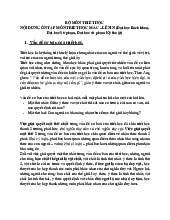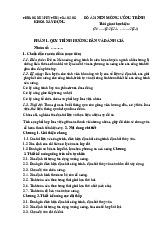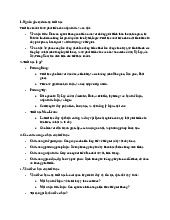
















Preview text:
Relativity Theory Relativity Theory
Laws of Physics in Inertial Frames
- Inertial frame is as good as another (equivalent). If there are two inertial frames moving
relative to each other, who is to say which one is moving and which one is at rest?
Accordingly, all laws of physics must be the same in any inertial frame. .
- Consider an inertial frame A with coordinates (x,y,z, t) and another inertial frame B with
coordinates (x',y’,z’,t') moving at constant velocity V in the x direction relative to A.
What we are saying is that the laws of physics must be the same regardless of whether you
are using the coordinates (x,y,z,t) of inertial frame A to describe the motion of an object, or
the coordinates (x',y’,z’,t') of inertial frame B.
x' x Vt V V V
x x'Vt V Relativity Theory
Galileo’s Principle of Relativity.
Using this relation, we can translate
the observations of the observer in
inertial frame A to that of the
observer in inertial frame B, and vice
versa. This translation prescription is known as the Galilean transformation. Mechanics views
v' v V ;
v v' V ;
dx’/dt = dx/dt –v; dý/dt =dy/dt; dz’/dt = dz/dt a' a a a'
The force F = ma in A and B is the same, the interaction in mechanical motion is the same,
No mechanics laws to identify which inertial frame is still or moving (Galileo Principle).
If the frame B moving with acceleration a relatively with A, the force in A and B is not the 0
same, the frame B is non-inertial. F = ma = m(a’+a ) ≠ ma’ = F’ 0
For example, the motion in our planet
How are the laws of physics on determine the inertial frame? Relativity Theory
The Special and General Theories of Relativity
The theory of relativity is a theory that deals with the motion of
objects when their speed is close to the speed of light c=3×108m/sec.
The Newton's second law seems not to be correct as speeds
approach the speed of light and must be modified.
The special theory of relativity only deals with the motion of objects
as seen from inertial frames.
The general theory of relativity extends it to cover non-inertial
frames as wel . We wil only be learning about the special theory of
relativity in this course because the general theory of relativity is super-duper difficult. Speeds of objects Inertial Frames Non-Inertial Frames much slower than Newton's Laws
Newton's Laws + Fake Forces c=3×108m/sec
General Theory of Relativity
Special Theory of Relativity close to
(to understand black holes, worm holes, (This is "relatively" c=3×108m/sec and other fancy stuff as easy to understand.) on Star Trek.) Relativity Theory
Einstein’s Postulates
1.The laws of physics, including electromagnetism, are the same in all inertial frames.
2. Every observer measures the same value c for the speed of light (in vacuum) in all inertial frames. What is relativity ? Relativity Theory
Relativity of Simultaneity
One of Einstein's thought experiments.
Two events occur at two points in a
same time. What is the simultaneity.
In a given frame of reference, an event is an
occurrence that has a definite position and time.
Whether or not two events at different x-axis
locations are simultaneous depends on the state of motion of the observer. Relativity Theory
Relativity of Time Intervals
What is the time intervals measured by two passengers: A in station and B in a train moving with speed v.
Passenger B observes a light pulse
The speed of light is the
emitted from a source at 0' and
same for both observers,
reflected hack along the same line. passenger B measures
Passenger A measures a longer time interval Δt: time interval Δt . o
The light pulse travels at same speed as in S', Passenger A
but travels a greater distance than in S'. observes the same ligh
pulse following a diagonal path. Relativity Theory Time Dilation
Two events occur at the same point in a same position. The time interval between these
events, as measured by an observer at rest in this same frame (frame of observer), is Δt . 0
Then an observer in a second frame moving with constant speed u relative to the rest
frame will measure the time interval to be Δt,
The event seems slower in moving frame (time dilation).
(observers measure any clock to run slow if it moves relative to them)
Due to the reason-results effect the correct relationship
occurs only when u < c.
The concept of simultaneity is involved. Relativity Theory Relativity of Length
The distance between two points may also depend on the observer's frame of reference. For the case
of a Lengths Parallel to the Relative Motion. . Pass. B Pass. B
The ruler is at rest in frame S', its
The length of the ruler in S is l, and
length in this frame is l . The time Δt 0 o
the time of travel from source to
required for a light to make the round Pass. A
mirror, as measured in S, is Δt . 1
trip from source to mirror and back is
The total length of path d from source to mirror is not l, but light constant speed c:
Similarly, the time Δt for the return trip in frame S 2 Relativity Theory Relativity of Length
The total time Δt = Δt + Δt 1 2 for the round trip,
The length of the ruler in S is l, and
the time of travel from source to
mirror, as measured in S, is Δt . 1
Finally, combining with we have
The length l measured in S, in which the ruler is moving, is shorter than the length l measured in 0 its rest frame S'.
Lengths that are measured Perpendicular to the Direction of Motion are not contracted.
The concept of simultaneity is also involved. Relativity Theory
The Lorentz Transformation
The question: When an event occurs at point (x, y, z) at time t in a frame of reference S, what are the
coordinates (x', y', z') and time t' of the event in a second frame S' moving relative to S with constant speed u in the +x-direction?
The coordinate x' is a proper length in S', so in S it is contracted as:
The form of the transformation from S to S' be identical to that from S' to S (with opposite sign of u).
lengths perpendicular to the direction of relative motion are not affected, so y' = y and z' = z. Relativity Theory The Lorentz Transformation
• Space and time become intertwined; length and time are dependent of the frame, and (x, y,
z, t) together is the space-time coordinates of an event. Velocity transformation Then similarity
Lorentz velocity transformations for one-dimensional motion. Notation
When u and v ˂˂ c, v’ = v – u ( x x x Galilean Transformation) If v’ = c x
• A body with a speed < c in one frame always has a speed < c in every other frame.
• No speed equal to or greater than that of light in vacuum,
• No distinction between the two frames S and S'. Relativity Theory Relativistic Momentum
Law of momentum conservation: when two bodies
interact, the total momentum is constant, it must be valid in all inertial frames
is not conserved in the second frame if use Lorentz transformation. . (m the rest mass)
• Relativistic momentum satisfies the law of momentum.
• as v approaches c, the momentum approaches infinity.
Relativity, Newton's Second Law, and Relativistic Mass
this result is still valid in relativistic mechanics
with that we use the relativistic momentum
correct generalization of Newton's second law
• Momentum is not directly proportional to velocity, the rate of change of momentum is not directly
proportional to the acceleration. And, constant force does not cause constant acceleration. Relativity Theory
Relativity, Newton's Second Law, and Relativistic Mass
• For example:. Motion and force is the same direction
• As a particle's speed increases, the acceleration caused by a given force continuously decreases.
• As the speed approaches c, the acceleration approaches zero,
Relativistic mass: Expression of relativistic momentum is sometimes interpreted as to mean
that mass of a moving particle increases.
• The total rest mass of a system of particles is the sum of the relativistic, not the sum of their rest masses.
Notation: From definition of momentum
• Motion and force is the same direction
• Motion in uniform circular at constant speed v.
Acceleration components depend on the parallel to and perpendicular force component.
Generally, the net force and acceleration vectors are not parallel. Relativity Theory
Relativistic Work and Energy
The kinetic energy K is a difference between total
energy E and an energy mc2 (rest energy).
for the kinetic energy K of a moving particle depends
on the motion and a second energy term mc2 Relativity Theory
Relativistic Work and Energy
• We can also relate the total energy E of a particle directly to its momentum by combining expression
for relativistic momentum and expression for total energy to eliminate the particle's velocity.
In the case of photon, m = 0 and
Newtonian mechanics and the special and general theories of relativity (a brief). Look for future




